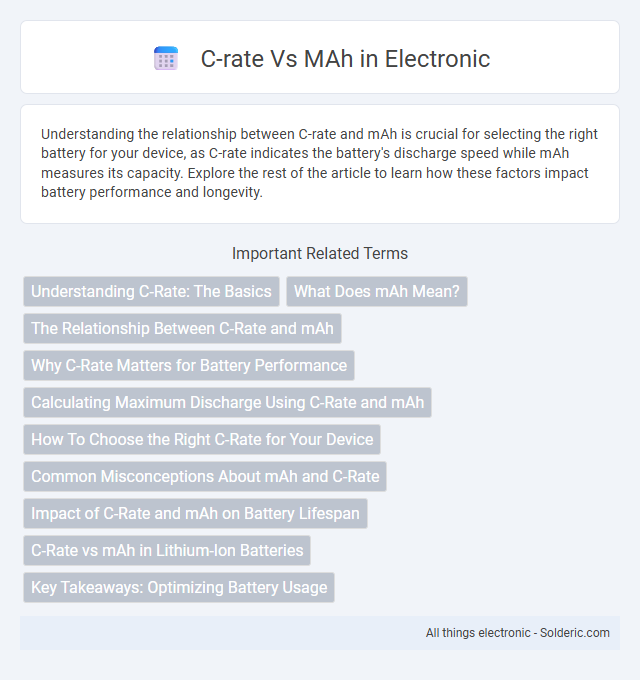Understanding the relationship between C-rate and mAh is crucial for selecting the right battery for your device, as C-rate indicates the battery's discharge speed while mAh measures its capacity. Explore the rest of the article to learn how these factors impact battery performance and longevity.
Comparison Table
| Parameter | C-rate | mAh (milliampere-hour) |
|---|---|---|
| Definition | Charge/discharge rate relative to battery capacity | Battery capacity measure representing charge stored |
| Unit | Dimensionless (ratio) | mAh (milliampere-hour) |
| Purpose | Indicates speed of charging/discharging | Indicates total usable battery charge capacity |
| Calculation | Current (A) / Battery capacity (Ah) | Current (mA) x Time (hours) |
| Example | 2C = 2 x battery capacity; charges/discharges twice the capacity per hour | 2000 mAh = can supply 2000 mA for 1 hour |
| Relevance | Used to specify charging/discharging rates for performance and safety | Used to specify battery runtime and total energy storage |
Understanding C-Rate: The Basics
C-rate measures the rate at which a battery charges or discharges relative to its capacity, expressed as a multiple of its mAh rating. For example, a 1C rate means the battery is charged or discharged in one hour, while a 2C rate doubles that speed, impacting battery performance and lifespan. Understanding C-rate helps you optimize charging cycles and maintain battery health by aligning the current with your battery's capacity in mAh.
What Does mAh Mean?
mAh, or milliampere-hour, measures a battery's energy capacity, indicating how much current a battery can supply over time before needing a recharge. A higher mAh rating means longer battery life, essential for devices requiring extended use. Unlike C-rate, which describes the discharge speed relative to capacity, mAh quantifies the total charge stored, directly affecting device runtime.
The Relationship Between C-Rate and mAh
C-rate measures the rate at which a battery discharges relative to its capacity, expressed in ampere-hours (mAh). A 1C rate indicates the battery discharges its entire capacity in one hour, so a 2000mAh battery at 1C delivers 2A of current. Increasing the C-rate results in faster discharge, but higher currents can reduce runtime and affect battery lifespan.
Why C-Rate Matters for Battery Performance
C-rate measures the rate at which a battery is discharged relative to its maximum capacity in mAh, directly impacting battery performance and longevity. Higher C-rates indicate faster energy release, essential for applications requiring bursts of power, while lower C-rates suggest slower, sustained energy delivery. Understanding the C-rate helps you select batteries that balance capacity and discharge speed for optimal device efficiency and lifespan.
Calculating Maximum Discharge Using C-Rate and mAh
Calculating maximum discharge current involves multiplying the battery's capacity in mAh by the C-rate, which denotes how fast the battery can safely be discharged relative to its capacity. For example, a 2000 mAh battery with a 5C rating can deliver a maximum discharge current of 10,000 mA or 10 A. This calculation is crucial for applications requiring precise power management to prevent battery damage and optimize performance.
How To Choose the Right C-Rate for Your Device
Choosing the right C-rate for your device depends on its power requirements and battery capacity measured in mAh. Higher C-rates indicate faster discharge capabilities, suitable for high-drain devices like drones or power tools, while lower C-rates are optimal for devices with steady, low current draw such as smartphones or laptops. Always match the C-rate to the device's maximum current draw to ensure efficient performance and avoid battery damage.
Common Misconceptions About mAh and C-Rate
Many users misunderstand mAh as a sole indicator of battery performance, while it only represents capacity, not discharge speed. C-rate defines the rate at which a battery can be safely discharged relative to its capacity, impacting power delivery and battery lifespan. Overlooking C-rate limitations can lead to excessive current draw, causing overheating or reduced battery efficiency despite high mAh ratings.
Impact of C-Rate and mAh on Battery Lifespan
C-rate determines the charge and discharge speed of a battery relative to its capacity, directly affecting heat generation and chemical stability during operation. Higher C-rates cause increased stress and faster capacity degradation, reducing overall battery lifespan. Conversely, batteries with higher mAh ratings store more energy, enabling longer usage time but often experience slower degradation at moderate C-rates due to decreased strain per unit of capacity.
C-Rate vs mAh in Lithium-Ion Batteries
C-rate in lithium-ion batteries defines the charge or discharge current relative to the battery's capacity, measured in ampere-hours (mAh), indicating how quickly the battery is charged or discharged. A 1C rate means the battery is charged or discharged at its full capacity in one hour, while higher C-rates enable faster charging or discharging without increasing the battery's mAh rating. Understanding the relationship between C-rate and mAh is crucial for optimizing battery performance, longevity, and safety in applications ranging from electric vehicles to portable electronics.
Key Takeaways: Optimizing Battery Usage
C-rate measures the rate at which a battery is discharged relative to its maximum capacity, while mAh (milliampere-hours) indicates the total charge a battery can store. Optimizing battery usage involves balancing C-rate and mAh to ensure efficient energy delivery without compromising battery lifespan or performance. Understanding your device's power requirements and matching them with the appropriate battery specifications helps maximize runtime and maintain battery health.
C-rate vs mAh Infographic

 solderic.com
solderic.com